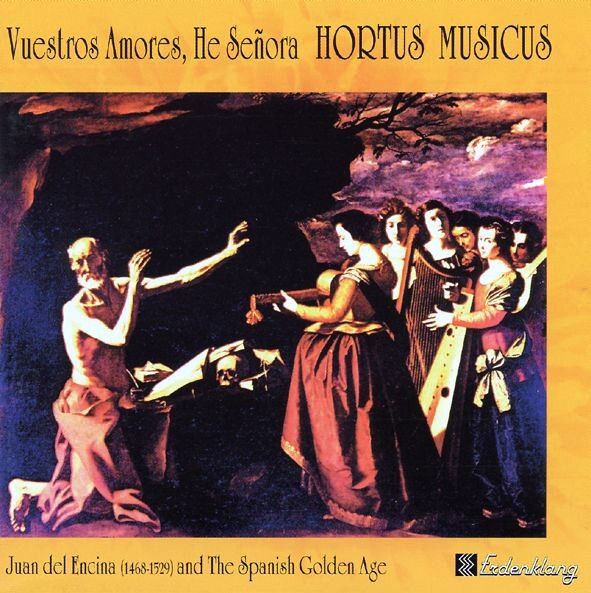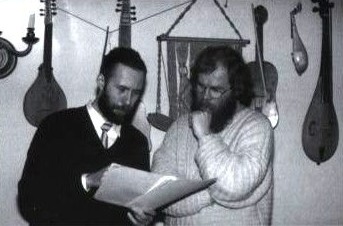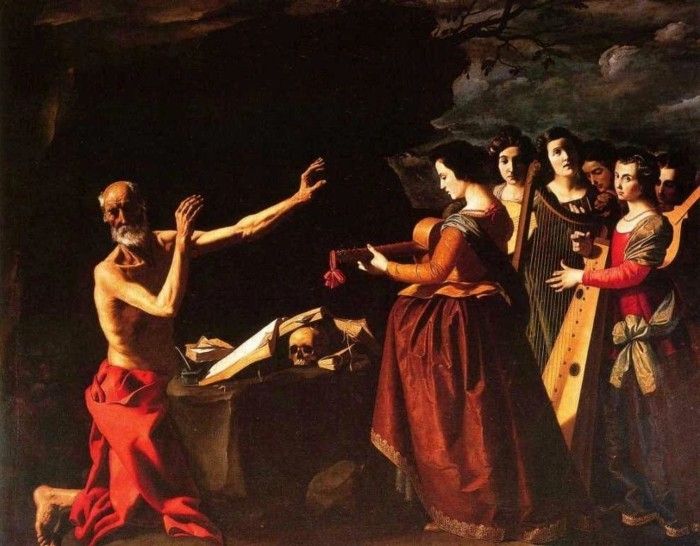
Erdenklang 57092
1995

Erdenklang 57092
1995
1. Si habrá en este baldrés [1:40]
Villancico à 4 über dem 'Folia'-Ostinato
2. Pues que jamás olvidaros [2:47]
Canción à 4
3. Caldero y llave Madona [2:45]
Villancico à 4
4. Recercada primera
[1:24] Diego ORTIZ
5. Vuestros amores he, Señora [3:32]
Villancico à 4
6. Ninguno cierre las puertas [4:54]
Villancico à 4 über dem 'Folia'-Ostinato
'Égloga representada la mesma noche de antruejo',
Fastnachtdienstag 1494
7. [2:54]
Qu'es de ti, desconsolado, Romance à 3
Levanta, Pascual, levanta, Villancico à 3
8. Señora de hermosura [2:44]
Villancico à 4 über dem 'Folia'-Ostinato
9. Recercada segunda
[1:15] Diego ORTIZ
10. Por unos puertos arriba [4:44]
11. Amor con fortuna [1:03]
Villancico à 4
12. Gasajémonos de huzia [2:26]
Villancico à 4
'Égloga representada por las mesmas personas', Weihnachtsabend
1494
13. Para verme con ventura [1:59]
Villancico à 3
14. Congoxa mas que cruel [2:01]
Villancico à 3
15. Recercada primera
[2:25] Diego ORTIZ
16. No tienen vado mis males [5:08]
Villancico à 4
17. Todos los bienes del mundo [1:23]
Villancico à 4
18. Hoy comamos y bevamos [1:37]
Villancico à 4 über dem 'Folia'-Ostinato
'Égloga representada la mesma noche de antruejo',
Fastnachtdienstag 1494
Hortus Musicus
Andres Mustonen
Compositions & lyrics by Juan del ENCINA (1468-1529)
except the instrumental pieces< by
Diego ORTIZ (ca.1510-?): Nos 4, 9 and 15.
Produced by Peeter Vähi
Creative direction and liner notes by Dr. Vladimir Ivanoff
Recorded without any cuts and editings, directly to the master
at the Linnahall-Studio, Tallinn, in 1992
engineered by Jüri Tamm
except #2, 7, 11 13:
at the Merchant Guild, Tallinn, in 1994
engineered by Priit Kulberg

The personal union of the kingdoms of Aragon and Castile in 1474, the
conquest of Granada in 1492 and the discovery of the New World in the
same year inaugurated a new era of Spanish politics, Spanish culture
and, in turn, of Spanish music.
This so-called "Golden Age", 'siglo de oro', - after the cleansing of
the Iberian peninsula of Muslims and Jews - promoted a specific,
nationally oriented form of the arts.
The aggressive Spanish domestic and foreign policies - inquisition,
expulsion of undesired ethnic and religious minorities, conquest of the
New World - also established the influence of the kingdom of
Castile-Aragon in Italy: clear indications of this are the Spanish Pope
Alexander VI and the conquest of the kingdom of Naples in the year 1504.
For example, Spanish musicians and composers (among them J. Escribano
C. Morales, T. L. de Victoria) were naturally present in Rome and
Naples (such as Diego Ortiz, from whom three instrumental pieces are
included in the present recording).
In contrast to their predecessors, Spanish nobility, above all the
'reyes catholicos' (the catholic kings: a title bestowed upon the king
and queen by Pope Alexander VI in 1496), preferred Spanish musicians
and composers for their chapel royal. Hardly influenced by the musical
customs prevalent in other European countries, these artists created
songs and instrumental pieces which impress even the modern audience
with their extraordinary freshness and spontaneity.They are frequently
adaptations of simple folk melodies, however, in such an emotional
manner that the performance of numerous 'romances' was forbidden in the
early years of the 16th century because they caused the listeners too
much pain and suffering.
The Castilian 'romance' which originated not later than the 14th
century, cultivated a courtly style similar to the French heroic epics,
telling about the war against the "heathens", of heroic deed, tragic
amorous adventures and Carolingian or pseudocarolingian themes. The
'villancico' is based on a medieval Spanish form of song which was
common mainly during the 14th and 15th centuries; however, in its
contemporary definition, it embraces the entire repertoire of strophic
songs with choruses.
In Spain successful songs were collected in songbooks ('Cancioneros').
Among others, compositions by Francisco Millán, Pedro Escobar,
Juan Ponce, Francisco de la Torre and, above all, Juan del Encina, were
published in these songbooks: the 'Cancionero Musical del Palacio'
alone includes 61 songs by this composer, perhaps he even compiled it
himself.
Juan del Encina was born in Salamanca in 1408 as a shoemaker's son.
Despite having been born in a lower social class, Juan was able to
study at the university in his native city. From 1484 he sang in the
Salamanca Cathedral Choir.
In 1492, Juan took part in the conquest of Granada as a soldier in the
service of the 'reyes catholicos'. Three of his songs (among them,
numbers 7/1-2 of this recording) relate to this historical
turning-point in Spanish history. In the same year, certainly by
recommendation of the chancellor of the university, Juan entered into
the service of his brother, Don Fadrique Alvarez de Toledo, the Duke of
Alba and nephew of King Ferdinand V of Aragon. Until 1496, the composer
with his humanistic and theological education entertained his employers
with music and plays ('Églogas' and 'Autos') in which he
frequently played the leading part.
Disappointed that he was not appointed to the Salamanca cathedral choir
as a permanently employed singer, Juan traveled to Rome in 1500 and was
introduced to the court of the Spanish Pope Alexander VI. His
successor, Pope Julius II, appointed Juan archdeacon at the Cathedral
of Malaga. Between 1508 and 1519. Juan del Encina was able to establish
himself both in Malaga and at the Popes court in Rome.
Juan was ordained as a priest in the spring of 1519 during a pilgrimage
to the Holy Land: he celebrated his first mass in Jerusalem (this is
reported in Juan's personal travelogue 'Via Sacra de Hierusalem',
published in Rome in 1521). Pope Leo X appointed him to the office of
prior at the Cathedral of León, where he died in 1529.
Juan del Encina is one of the typical contradictory personalities, one
of the "flexible" talents of the Renaissance. His career as composer,
dramatist and humanist on the one hand, and as a clergyman and
influential church politician‚ on the other hand, was traced out
by his family: Juan's oldest brother lectured on musical theory at the
university of Salamanca; another of his brothers, Miguel, was a priest
and singer in the cathedral choir.
Sponsored by three powerful popes, Juan del Encina probably made just a
many enemies as friends. As a clergyman he strove to dismiss his
worldly and in part erotic 'villancicos' as meaningless youthful
follies: he had created his entire literary, scientific and musical
oeuvre before he was thirty years old. However, his plays and
particularly his songs, gave Juan a name in theater history as
'patriarca del teatro español': a committed church politician
and clergyman with a dominant worldly musical heritage - in most cases
two 'villancicos' are the interlude and conclusion of his plays
(Numbers 6, 12 & 18 of the present recording were used for this
purpose).
Juan was particularly fond of using the 'folia' ostinato, taken from
dancing music, as the basis for his compositions (Numbers 1, 6 & 18
of the present recording). The 'folia' and other ostinato forms were
first systematically collected by Diego Ortiz as the basis for
instrumental variations in his 'Tratado de glosas sobre clausulas'
(Rome1553, Numbers 4, 9 and 15 of the present recording). As Encina in
Salamanca before him, Ortiz also worked for the Alba family in Naples.
Juan del Encina's early 'églogas' for the Duke of Alba were
still patterned on the medieval mysteries for important Christian
holidays, however, they were already dominated by a rustic folk
atmosphere. It is quite understandable that the humanistically inspired
author left us a Spanish version of Virgil's 'Bucolica', and that his
later dramatic work focused on ancient amorous themes and pastoral
plays.
He did not leave us a single truly religious or liturgical piece of
music, however, numerous emotional songs: his own expressive, roguish
or erotic texts set to music.
The songs and plays by Juan del Encina, as well as his scientific
articles (including a treatise of the Castilian language), dispaly an
interaction of education and popular tradition in an unrivalled manner:
the golden years of the 'Renaissance'.
Dr. Vladimir Ivanoff
Translated by David Jessup
